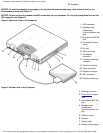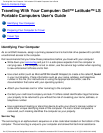
CAUTION: A CAUTION indicates the potential for bodily harm and tells you how
to avoid the problem.
Typographical Conventions
The following list defines (where appropriate) and illustrates typographical conventions used as
visual cues for specific elements of text throughout this document:
Interface components are window titles, button and icon names, menu names and
selections, and other options that appear on the monitor screen or display. They are
presented in bold.
●
Example: Click OK.
Keycaps, the labeling that appears on the keys on a keyboard, are enclosed in angle
brackets.
Example: <Enter>
●
Key combinations are series of keys to be pressed simultaneously (unless otherwise
indicated) to perform a single function.
●
Example: <Ctrl><Alt><Enter>
Commands presented in lowercase bold are for reference purposes only and are not
intended to be typed at that particular point in the discussion.
Example: "Use the setup command to . . . ."
In contrast, commands presented in the Courier New font are intended to be typed as
part of an instruction.
Example: "Type format a: to format the diskette in drive A."
●
Filenames and directory names are presented in lowercase bold.
Examples: autoexec.bat and c:\windows
●
Syntax lines consist of a command and all its possible parameters. Commands are
displayed in lowercase bold; variable parameters (those for which you substitute a value)
are displayed in lowercase italics; constant parameters are displayed in lowercase bold.
The brackets indicate items that are optional.
Example: del [drive:] [[path]filename] [/p]
●
Command lines consist of a command and may include one or more of the command's
possible parameters. Command lines are presented in the Courier New font.
Example: del c:\myfile.doc
●
Screen text is text that appears on the screen of your display or external monitor. It can●
Preface: Dell Latitude LS Portable Computers User's Guide
file:///C|/Documents and Settings/Administrator/De...w Web/Documentation/LS/LS User's Guide/preface.htm (3 of 4) [5/31/2000 9:42:04 AM]


















